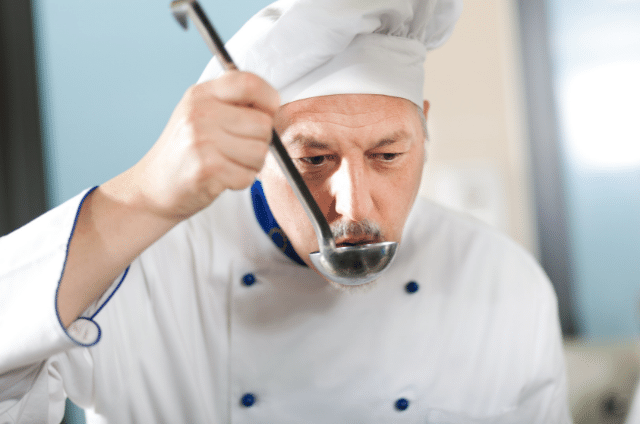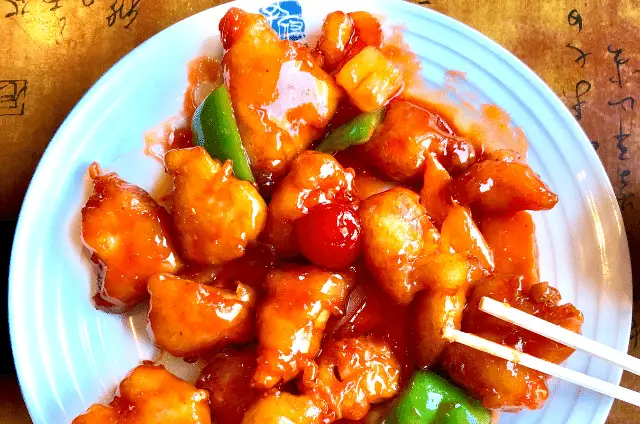There have been a lot of rumors going around recently about the quality of the food you’re receiving when you order Chinese. I talked to waiters and cooks at a handful of Chinese restaurants to see what is really in your Chinese food.
The rumors are false: Chinese food is made of whatever it says on the menu. If it says it’s made of chicken, it’s chicken; if it says beef, it’s beef. The quality of the chicken or beef varies from restaurant to restaurant, but there’s no “Mystery Meat” being served at Chinese restaurants.
While I was relieved to find that Chinese restaurants really serve the ingredients they claim to, I wanted to find out more about Chinese food: why it tastes the way it tastes, and what gave rise to the many urban myths I’ve heard about Chinese restaurants serving “mystery meat.”
What Chinese Restaurants Serve, the Rumors About Chinese Food, and Why They Aren’t True
While indisputably delicious, urban myths have sprouted all over America, questioning the unusual tenderness and flavor of the meat served at Chinese restaurants. While it is usually listed on the menu as chicken, beef, or pork, some believe that it is actually a “mystery meat” containing a range of animals, including rats, cats, and dogs.
The rumors are entirely false. Let me explain why, where these rumors come from, and what the truth actually is.
Economics and Supply

People believe Chinese-American restaurants serve “mystery meat” as a cheaper alternative to genuine pork, chicken, or beef. But think about it: have you ever seen the cat, dog, or rat meat in any store, anywhere in America?
The simple truth is that these unusual meats are not available to restaurants in America. You may be able to find them in some extremely specialty-based stores, but they will cost a lot more. The US does not have any trade-in cat, dog, or rat meat.
On the other hand, wholesale beef, chicken, or pork can be incredibly cheap for restaurants, particularly lower-quality cuts and grades. Serving “mystery meat” would cost a lot more than the usual meats.
Health Inspections

The US also has a governing body (the Food and Drug Administration, or FDA) to ensure that restaurants and food establishments are serving food safely to their customers.
All restaurants across the country are subject to FDA inspections, often at random. The inspectors come in and examine the kitchen to assure that customers are really receiving what they’re ordering and that they’re receiving it safely.
Sure, many of us have probably had food poisoning a couple of times from eating Chinese food. But the FDA assures that if a menu says “beef,” you’re really getting “beef.” The quality of that beef may be relatively low, but you can be certain that it really does come from a cow and not a cat, dog, rat, or some other animal.
You can trust the thoroughness of these FDA inspections. They are quite rigorous. If there’s a box of dog or cat carcasses in the back somewhere, the inspector is going to find it and close down the restaurant. Fear not – there is no evidence to suggest that Chinese restaurants are serving any strange, unusual meats.
Taste

Let’s pretend for a moment that Chinese restaurants really were serving some sort of “mystery meat.” Why would they serve it?
Since it wouldn’t be economical or easy for them, maybe they would be serving such a dish to capture a particular, delicious flavor. After all, one reason “mystery meat” rumors are believed is that the meat at Chinese restaurants is just so darn soft and tasty!
But since it’s neither cheaper nor easier than serving genuine stock animals, wouldn’t they be proud of their exotic dish? If (and that’s a big “if”) they were serving strange, delicious meat, they would be doing it at no small cost, and they would be likely to tell you upfront what you’re getting rather than selling it as cheaper meat like beef or pork.
The Truth About Tenderness
I mentioned that Chinese restaurants, and most other restaurants, can buy meat for low prices when they buy wholesale, especially if they buy lower grades of meat. While some cheaper cuts can be a lot less tender, there’s a secret of the trade about tenderizing.
Try this at home sometimes: take a stiff piece of meat and soak it overnight in a combination of water and baking soda. When you cook it the next day, you’ll be amazed at how soft, tender, and flavorful it is. In fact, you’ll instantly recognize the flavor – It’s exactly the same as the meat you’re getting at your local Chinese place.
Many Chinese restaurants in America practice this, and it’s one reason why the “mystery meat” rumors arose in the first place. To make cheaper, lower-quality meat tastes delicious, it can be tenderized by soaking it overnight in baking soda and water. This is the most popular way to tenderize, but other methods exist too.
The Secret Sauce
If you eat a lot of Chinese food in America, you’ll also eventually realize that it’s not the meat or vegetables that give the dishes the most flavor – it’s the sauces.
In the US, we love our Chinese food to be sweet and fried. More often than not, this comes from sauces rather than meats and other ingredients.
Here’s the catch, though – the other ingredients will usually be sliced pretty small, like little bite-sized pieces of meat, for example. This gives them more surface area to absorb the sauce and deliver and tasty flavor. The small piece size is not to mask the identity of some strange meat content, as is sometimes rumored, but to deliver flavor.
The Coronavirus Rumor
To be honest, this rumor seems especially unfair to me. Maybe you’ve heard it; maybe you haven’t: COVID-19 started in China, and some Americans think that eating Chinese food will infect them with it.
It’s a shame because while this rumor is false, all Chinese restaurants across the US have had less business during the Coronavirus pandemic. Many have struggled and have been forced to close.
The origins of this rumor are similar to the “mystery meat.” Since the Coronavirus is thought to have started and spread because of human contact with particular animals, some people fear that if Chinese food does contain “mystery meat,” then it could potentially infect them.
Not only does Chinese food not contain “mystery meat,” but thoroughly cooked foods will not transmit viruses anyway. Even in mainland China, where you might be more likely to see exotic meats in restaurants, all meat is always cooked. Chinese food is never served raw, so you don’t have to worry about your food containing the Coronavirus.
Chinese Food In America

Let’s talk for a moment about what makes Chinese food what it is. There are countless Chinese restaurants in America. In the US, Chinese restaurants number even more than the combination of all the McDonald’s, Burger King, and Kentucky Fried Chicken restaurants, according to author Jennifer 8. Lee.
There’s a key difference between franchise restaurants and your local Chinese place, though. Franchise restaurants like McDonald’s all operate under the same brand, which ensures consistent quality and character to the food from location to location. Your local McDonald’s serves the same burgers as the one in the next town or state over.
Chinese food restaurants, on the other hand, have no unified brand. With the exceptions of Panda Express or P.F. Chang’s, almost all of the thousands of Chinese restaurants in the United States are single-location, family-owned establishments. Think “mom-and-pop” style places.
Because of this, each Chinese food restaurant in America puts its spin on the many dishes on its menu, cooking each in its way. While all will serve the most popular dish in America – General Tso’s Chicken – each will cook it in its own unique, delicious way.
What’s on the menu at Chinese Restaurants in America
(check it out: Authentic Chinese food vs American Chinese food)
Chinese food menus are fairly consistent across the US – it’s just how the food is cooked that varies. But what determines what’s on the menu in the first place? Where did Chinese-American cuisine originate?
It turns out that Chinese-American food and mainland-China Chinese food have a lot of similarities and differences. The origin is in the food’s history. Chinese-American food was born, unsurprisingly, when immigrants moved from China to the US, particularly between the 19th century and the first half of the 20th century.
A majority of the immigrants came from a few provinces: Fujian, Hong Kong, Guangdong, Sichuan, Hunan, and Beijing. Because of this, Chinese-American cuisine is most similar to food from this handful of regions. Many other regions, like Anhui, are almost entirely unrepresented in Chinese-American cuisine.
The many saucy, fried dishes at your local Chinese place are likely most similar to dishes from these few regions in China. In America, restaurants began making the food their own to create a unique Chinese-American cuisine. Dishes like chop suey or beef with broccoli have no origin in China – they are purely an American invention.
Chinese Food In China
As it turns out, Chinese-American food is markedly different than Chinese food in China. To understand where the rumors about Chinese-American food arise, we have to discover what Chinese food is really all about.
What’s in Chinese Food in China? – The Staples
What’s used in authentic, mainland Chinese cooking? Here’s a short list of the most popularly used ingredients in Chinese cuisine:
- Rice. The Chinese eat rice every day, and it forms the backbone of their cuisine. Almost all meals are served with rice, and rice can be eaten by itself as well.
- Noodles. If a dish doesn’t contain rice, it probably has noodles. Noodles served in a soupy broth are less common in the United States, but these are also popular in China.
- Meats. The most popular meat in China is pork. Generally, the Chinese prefer dark meats, whereas Americans prefer lighter meats like chicken. While Chinese-American food usually only contains the usual meats like chicken, pork, beef, and occasionally duck, in mainland China, they eat a huge variety of animals beyond this, including pigeons, quail, frogs, and rabbits. And instead of just taking a cut from these animals, it’s common for the Chinese to cook and eat all parts of the animal.
- Eggs. Authentic Chinese cooking uses a lot more eggs than Chinese-American food. They don’t just use chicken eggs, but also quail, duck, goose, or pigeon eggs too.
- Tofu. Made from soy, water, and a curdling agent, tofu is a popular protein in both Chinese and Chinese-American cuisines.
- Vegetables. Chinese cuisine tends to use a variety of vegetables, especially leafy greens, white radishes, Chinese eggplants, mushrooms, onions, soybean sprouts, string beans, carrots, and bamboo shoots. Some Chinese-American restaurants use these same ingredients, but they can be much harder to source in the United States.
- Spices and Seasonings. The most popular flavor-booster in China is ginger, which can be added to almost any dish to give it a little extra taste. Garlic, chili peppers, green onions, and coriander are also popular.
(Source: China Highlights)
You may notice that authentic Chinese cooking is a bit different than what you find at your local Chinese restaurant. Generally, Chinese food uses a wider spread of ingredients and also will be cooked differently: mainland Chinese food is more commonly stir-fried or steamed than Chinese-American food.
Hungry History and Delicacies
The Chinese eat a much wider range of proteins and vegetables than are found on menus in America. You may have heard of rumors of some rather exotic dishes, such as frog legs, which may not sound particularly appetizing to you. It’s important to understand the origin of these special dishes too.
The Great Leap Forward
Chairman Mao Zedong led China for much of the 1900s. A communist, he wanted to centralize the food and agriculture system and launched the Great Leap Forward between 1958-and 1961. Centralization meant establishing quotas for farmers and redistributing their harvests.
Local officials were required to collect certain quotas of food from each farmer. To please their superiors, “surpluses” would often be reported and taken – even when the farmers didn’t actually have any extra surplus crops to give.
Millions of farmers starved as a result. The Great Leap Forward created the Great Chinese Famine, in which between 33 and 55 million people starved to death. This gives it one of the largest death counts out of any event in all of human history.
With such a scarcity of food, the Chinese couldn’t be picky eaters. They ate whatever they could get their hands on. Stories arose during this period of eating cats, dogs, rats, and even dead humans. With widespread starvation, they didn’t have much choice. Any animal that was used for food was used in its entirety, with no parts left uneaten.
The Present Day
Rumors today suggest that Chinese food still contains the pandora’s box of meats and ingredients that were consumed during the Great Chinese Famine. In large part, these rumors are not true, and in America, none of these meats are consumed. However, there is a sliver of truth in mainland China.
If you’ve ever traveled to China, you’ll know that some exotic foods still can be found and are considered delicacies. It’s not too hard to find places serving frog legs, rabbits, jellyfish, and all manner of oddly-shaped and strange-looking foods. Today, these are eaten as delicacies.
What makes a delicacy a delicacy? In most places, rarity is an important factor. Furthermore, Chinese food is all about texture. While Chinese-American food rarely has bones or strange animal parts in it, remember – the Chinese eat all parts of the animal. Chicken feet, which aren’t particularly flavorful, are enjoyed for their diverse texture.
Do They Really Eat Cats and Dogs?
(check it out: what kind of meat does chinese restaurant use)
Chinese delicacies are often criticized because here in the West; we’d never consider eating domesticated animals like cats or dogs. Rumor has it that the Chinese commonly eat these animals, and Westerners often project our values to suggest that this is sacrilegious, disgusting, and unethical.
So what’s the deal with Chinese eating cats and dogs? It is largely untrue. Outside of the Great Chinese Famine – when the Chinese ate anything and everything to stay the threat of starvation – the Chinese don’t generally eat cats and dogs. Even in exotic, delicacy-serving restaurants, these animals would be hard to find.
However, there is some history. It is thought that over 4,000 years ago, medicine men praised dog meat as a remedy for the summer heat. And in two regions – Guangdong and Guangxi – dog and cat meat are still considered delicacies today, but they are much less common than Westerners make them out to be.
China doesn’t have strict laws prohibiting or punishing animal cruelty, either. But, to improve its image in the eyes of the world, the government has begun taking stricter measures around eating cats and dogs. In 2017, for example, all trade of dog meat was banned and strictly punished for one week.
Conclusion
So what’s really in Chinese food? Whatever it says on the menu! There’s no reason to worry and think otherwise. In the US, the FDA protects our food system, and it wouldn’t make sense for restaurants to serve “mystery meat” anyway. Even in China, cat and dog meats are extremely uncommon. So don’t worry – your food is safe to eat.
